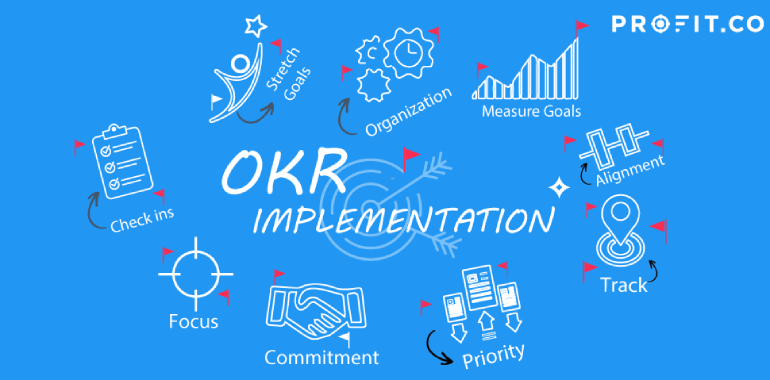Introduction
Profit.co has this unique PEEL approach to implementing OKRs, which stands for plan, execute, engage, and learn, and then cycles back to plan. We have built features into our Profit.co company that makes it easy for companies to go through this cycle as they engage with OKR planning. Although we came up with this plan, execute, engage, learn cycle, there are many similarities between Profit.co’s PEEL approach and other OKR implementation techniques recommended by several OKR practitioners/coaches. When we shared this idea with them, we instantly saw a lot of nods and confirmation that most of them use something similar in their coaching.
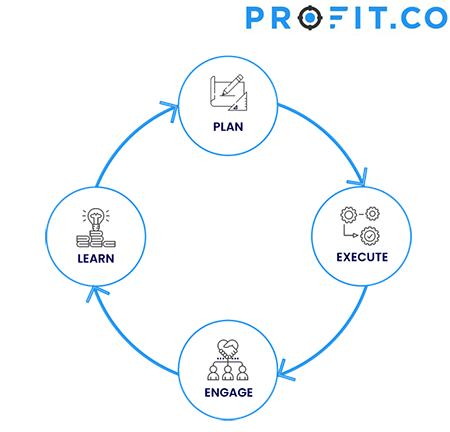
It is very important to realize that OKR is not a single activity, but an activity system. The best way to think of your OKR journey is to imagine that you are riding a vehicle that runs on 4 wheels. All these 4 wheels need to be operated in a coordinated manner to ensure you get the best results from your OKR program.
And when we talk about driving, we become better drivers over time. We can listen to music, sing while driving, attend conference calls while driving and so on. After multiple years of driving, you don’t even realize that you are driving. Driving became a habit.

When it comes to problems in this journey, we want to phrase these not really as issues that cause OKR implementations to fail, but we would rather call these as red flags in these four areas that need to be addressed properly. Otherwise you could end up with a failed implementation in your hand.
Some of these red flags may seem to be generic and not specific to OKRs. But they do have an OKR angle in most cases. In other cases where there is no direct angle, it is important to know that OKRs won’t solve that problem. As already mentioned, OKRs are a way of doing business and don’t simply lift and shift your business into a whole new world.
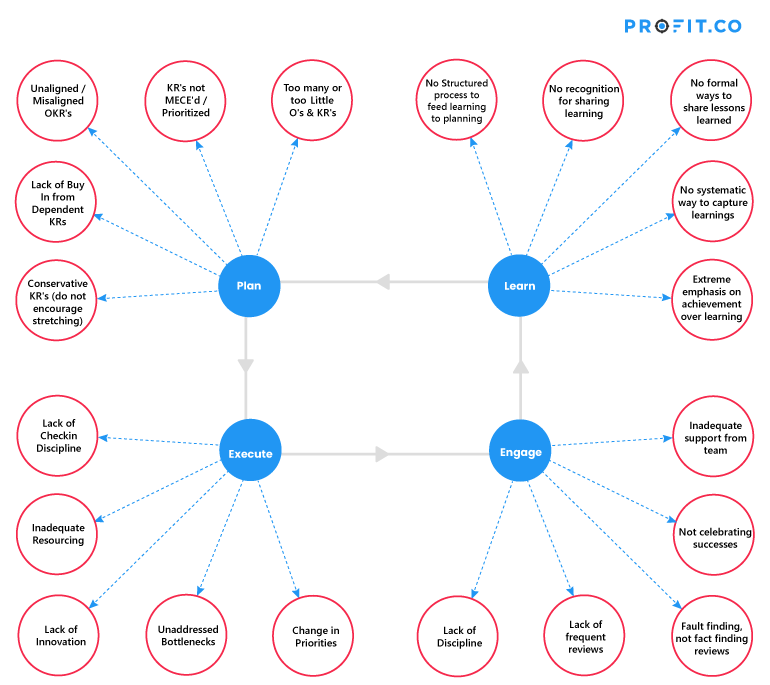
These four areas are interestingly ordered by the perceived level of importance in most OKR programs. Most companies pay a lot of attention to OKR planning, slightly lesser attention to execution, and even less to engaging and pretty much ignore learning. But in our opinion, at least, they are all equal. The four stages of the OKR PEEL cycle all have to be given equal attention and emphasis to make any OKR program extremely successful.
Ready to start your OKR journey for FREE?
Planning Red Flags
Planning is the first step in OKRs. Needless to say, a trip without a plan is a trip to nowhere. And hence many OKR practitioners and software place a lot of emphasis on planning. In fact, we’ve seen many businesses equate OKR planning to OKR practice, which is absolutely not true. They tend to put a ton of emphasis on planning and then believe that they are practicing OKRs.
While we think planning is the most mature aspect of OKRs in many implementations, there are red flags that you should be aware of to ensure that you successfully navigate through them to avoid the planning pitfalls.
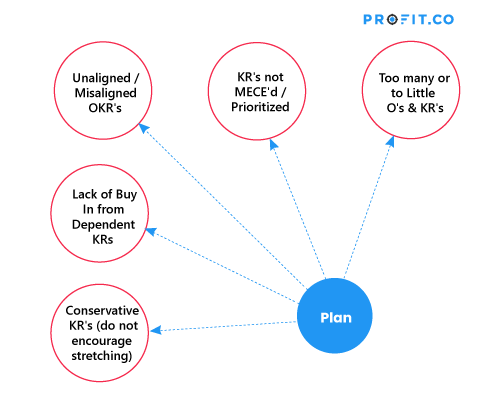
Too many or too little O’s and KR’s
Ideally you have 3-4 Objectives with 3-5 key results for each objective for a company/department/individual as the case may be. Which is kind of the middle ground. On one end, you may have a lesser number of objectives and/or a lesser number of key results per objective. On the other end, you may have a lot of objectives and/or a lot of key results for each objective.
KR is not MECE’d or prioritizedWhen you have an OKR that has 3-5 KRs, you will hope to see the Objective getting achieved as you achieve your key results. While this may be happening in your tracking sheet or software, you may notice that the objective is really not getting achieved. Your key results are tracking fantastic, but the objective is at a standstill or has very little movement. The situation you have in your hand is one where your key results are not comprehensive or prioritized or both.
 In general, when you try to create KRs, people come up with a list which is not prioritized and many times not even complete.
In general, when you try to create KRs, people come up with a list which is not prioritized and many times not even complete.  Not always, but in this case where you’ve planned your key results poorly, you also have a tracking problem. Even if you achieve all the key results, you’ll still end up not attaining your objective.
Not always, but in this case where you’ve planned your key results poorly, you also have a tracking problem. Even if you achieve all the key results, you’ll still end up not attaining your objective.
Unaligned or Misaligned OKRsUnaligned OKRs may mean wasted effort, but not necessarily. You go through a few strategy sessions and come up with your corporate OKRs. They are kind of set in stone. The next level departments should create and implement OKRs based on what they need to achieve to help the company as a whole achieve the corporate OKRs. And then the sub-departments’ OKRs are created in such a way that they first. But as we already mentioned, there will be OKRs that are not necessarily aligned upwards. So unaligned by itself is not a problem, but if you have only unaligned OKRs, you clearly have a problem.
Misaligned OKRs signal chaos and confusion. It’s important to promote a culture of clarity. You want alignment, but not a situation where you find “reasons” to align. If you say that there is alignment, it should be clearly demonstrated. Anyone who looks at the two OKRs should be able to find the linkage without a lot of explanation. Else the perceived alignment would really be a distraction.
 If everything is unaligned, you clearly have a problem. When you do have people and functions running around in different directions, you will have alignment issues, which is one of those core tenets of OKRs.
If everything is unaligned, you clearly have a problem. When you do have people and functions running around in different directions, you will have alignment issues, which is one of those core tenets of OKRs.
Lack of buy-in from dependent KRs
Different business functions in a company depend on each other to accomplish the collective objective of the company. When your organization is bigger and spread out, dependencies are more pronounced and the need to adequately negotiate, clarify and agree on commitments is much higher.
So for you to achieve your OKRs you will need somebody else to keep their end of the bargain. You need to have adequate conversations with them beforehand and make sure that the dependencies are clearly understood and you have a commitment from them that they will complete their OKRs or schedule it appropriately, so you can complete yours.
 A very common misunderstanding in early days of OKRs is, that once I put my OKRs in I am assured of the commitments from other departments. That is flawed. There are no such guarantees. When you don’t have their commitments, you can’t be sure of committing to and achieving your OKRs. So, you need to go through the negotiation process and ensure you have commitments.
A very common misunderstanding in early days of OKRs is, that once I put my OKRs in I am assured of the commitments from other departments. That is flawed. There are no such guarantees. When you don’t have their commitments, you can’t be sure of committing to and achieving your OKRs. So, you need to go through the negotiation process and ensure you have commitments.
 Once you achieve commitments from departments/teams that you depend on, you need to track those OKRs regularly to ensure that you are aware of their progress and challenges.
Once you achieve commitments from departments/teams that you depend on, you need to track those OKRs regularly to ensure that you are aware of their progress and challenges.
Conservative Key Results
This is not about the number of objectives and key results, but the nature of your objectives and key results– or, the quality of your OKRs. It’s more about the target that you’re trying to achieve. So, I had 40 million users last year and could shoot for 100 million users this year. If I put my OKR to be like 60 million that’s clearly conservative assuming you got to 40 million in a couple of years, getting to 50, 60 million in the third year is not such a big deal. So you just have to come up with ways in which you prevent these conservative KRs.
 This is a clear violation of the stretching principle. Watch out for sandbagging in your planning sessions. The best way to overcome this problem is to stay aggressive, but be realistic. There should be a logic behind the “achievability” of the numbers. It can’t be just based on hope and wish.
This is a clear violation of the stretching principle. Watch out for sandbagging in your planning sessions. The best way to overcome this problem is to stay aggressive, but be realistic. There should be a logic behind the “achievability” of the numbers. It can’t be just based on hope and wish.
Execution Red Flags
Now let’s look at the five red flags that you see while executing your OKRs.
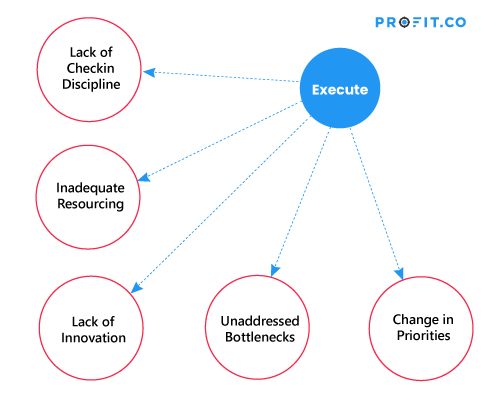
Lack of Check-In Discipline
Number one is lack of check indiscipline. This would seem trivial, but this is the number one problem reported by all the clients that we have spoken to. Checking in discipline is an important topic clients want to discuss when they ask how to implement OKRs.
People have to take check-ins seriously. They have to check in on time, as well as provide appropriate supporting information as to:
- What was achieved?
- What was not achieved?
- What they learned over that period?
So it’s not just about reporting a number. It’s about checking in with adequate information support.
 Check-ins have to become habitual. An organization should be committed to make this a habit. Certainly, software reminders help getting check-ins done on time, but if check-ins don’t become common language in conversations — informal hallway conversations to formal reviews, you will have an organizational level “commitment” problem.
Check-ins have to become habitual. An organization should be committed to make this a habit. Certainly, software reminders help getting check-ins done on time, but if check-ins don’t become common language in conversations — informal hallway conversations to formal reviews, you will have an organizational level “commitment” problem.
 If you don’t have quality check-ins on time, then you are not really tracking what is happening, what is supposed to happen and how. Your OKR program won’t even take off if you have tracking problems like this.
If you don’t have quality check-ins on time, then you are not really tracking what is happening, what is supposed to happen and how. Your OKR program won’t even take off if you have tracking problems like this.
Inadequate resourcing
Resourcing here means all kinds of resources, not just for people, like inadequate. Every type of resource has to be understood and analyzed. If you have an infinite amount of every resource you need, you probably don’t need OKRs. But we know that is not the reality. Understanding what you have in your hand, where do you need to get to, and how the resources you have in your hand can get you there is very important.
There will always be constraints. But there has to be a path to where you want to get to with what you have in your hand. As an organization, you have to put your money where your mouth is. You can’t really say I need 40 million users this year, but then not back it up with adequate investment that is needed in terms of maybe appropriate tools, appropriate access to technology, appropriate type of people, quantity of people, to solve the problem.
 As already mentioned, you have to put your money where your mouth is. Else, as an organization your commitment will be questioned.
As already mentioned, you have to put your money where your mouth is. Else, as an organization your commitment will be questioned.
Lack of innovation
Lack of innovation could be thought of as a special type of “resource” problem. But you may also have rigid processes that drive innovation out of the system. Lack of innovation hence can be a cultural problem, people problem or process problem. But the bottom line is that if you don’t have innovative thinking, you have a serious problem.
Good OKRs will automatically push people to be more innovative, but if your people are not prepared you will end up with a “OKRs didn’t work for us” or a “sour grapes” situation. You may be able to get by in some cases but you will consistently fail to reach your stretch goals.
 You won’t really have a tracking problem, but you will end up with check-ins that seem to be stuck in the same place.
You won’t really have a tracking problem, but you will end up with check-ins that seem to be stuck in the same place. Your stretch goals will consistently fail. It is normal to not hit all the stretch goals. But if you don’t reach any of them, you have to question. Either you have a quantity or a quality problem with your resources or processes.
Your stretch goals will consistently fail. It is normal to not hit all the stretch goals. But if you don’t reach any of them, you have to question. Either you have a quantity or a quality problem with your resources or processes.
Unaddressed bottlenecks
Bottlenecks exist in business processes. Unaddressed bottlenecks is a huge process issue. Your people get going but they are blocked by a bunch of roadblocks or bottlenecks which they can’t really address by themselves. They need help from somebody else, management or other departments to get moving again. And this will hamper execution significantly.
 An important role that management needs to play in the OKR world is to get the field ready for the players. You can’t let your players play in a field that is not conducive for play. When you push your employees to “stretch”, you need to have the same level of commitment to ensure you don’t really leave your people out there getting slaughtered.
An important role that management needs to play in the OKR world is to get the field ready for the players. You can’t let your players play in a field that is not conducive for play. When you push your employees to “stretch”, you need to have the same level of commitment to ensure you don’t really leave your people out there getting slaughtered. Bottlenecks will impact outcomes and if you don’t address your bottlenecks you are going to be left with OKRs that are stuck.
Bottlenecks will impact outcomes and if you don’t address your bottlenecks you are going to be left with OKRs that are stuck.
Change in priorities
Change is the only constant in the world. So, priority change is not really a problem by itself. But not recognizing that priorities have changed and rehashing the appropriate OKRs, ensuring alignment with the changed priorities is important. You will have an objective and a key result, you will be executing for a month into the cycle. And then you won’t be able to focus on it for another two more months in the quarter, because something really, really more urgent, business-critical, came in and you’re having to spend your time on that.
Now, an ideal way to handle this would be to create new OKRs to reflect that change in priority, and then push the current ones that you are working on into some sort of a backlog mode, and then bring it back when appropriate. As long as you recognize the change in priorities properly and support it, and ensure that it is handled and tracked properly, you’re good. But many times we see that they are not properly reflected back in OKRs. That then leads to an inappropriate conclusion that the OKR program is not working.
 Change in priorities directly results in a change in focus, if not at the highest levels, at the next levels. This has to be understood well and accommodated.
Change in priorities directly results in a change in focus, if not at the highest levels, at the next levels. This has to be understood well and accommodated. If you don’t account for changed priorities your tracking will go haywire. Your OKRs will be in the read and your team will be busy doing the things that they are supposedly told as the priority, but their OKRs don’t reflect them. Suddenly you’ll realize that your team doesn’t think its necessary to check-in and you will lose your check indiscipline. And that will lead to more red flags.
If you don’t account for changed priorities your tracking will go haywire. Your OKRs will be in the read and your team will be busy doing the things that they are supposedly told as the priority, but their OKRs don’t reflect them. Suddenly you’ll realize that your team doesn’t think its necessary to check-in and you will lose your check indiscipline. And that will lead to more red flags.
Engagement
Now, let’s look at the third big family of problems, which is around engagement.
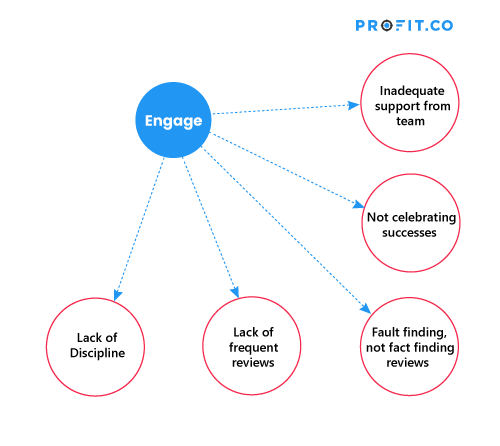
Lack of Discipline
If you ask what is the #1 problem with traditional goal-setting processes, 9 out of 10 will say that you just forgot about the exercise after the goals were set. You can blame that on many things, but that’s the one thing you cannot do with OKRs. “Okay, I put my OKRs, now I’m doing my own thing” — nah nah, can’t happen.
If you go through a rigorous process of setting your OKRs and then if you just ignore them for the rest of the quarter or year as the case may be, you’re better off without OKRs. We talked about check-in discipline earlier. But on the engagement side it’s even more important for the owners of objectives and key results to work hard and move the needle.
 You could have commitment issues with OKRs or the results that someone is supposed to deliver. But you surely have something to worry about.
You could have commitment issues with OKRs or the results that someone is supposed to deliver. But you surely have something to worry about. If you have a solid tracking process and system, this problem will surface really early and can be corrected.
If you have a solid tracking process and system, this problem will surface really early and can be corrected.
Lack of frequent reviews
As you may have started to realize, these red flags are interrelated as you normally see in activity systems. If you conduct frequent reviews of your OKRs, at least once a week many of the other red flags will vanish automatically. On the other hand, if you don’t conduct reviews periodically many of the other problems will just get amplified.
If you have a managerial process where you review OKR progress regularly, say weekly and encourage your next levels to do the same, your OKR program will soar and the business results you see will motivate you to make OKRs habitual.
 Most managers review progress. Just ensure that OKRs are part of the review process. In our experience, this is the single most important factor that determines the fate of any OKR program.
Most managers review progress. Just ensure that OKRs are part of the review process. In our experience, this is the single most important factor that determines the fate of any OKR program. Many times we see clients using spreadsheets and/or KPI dashboards to review their key numbers. It makes sense. If you incorporate OKRs into your review process and use these spreadsheets and dashboards as backups behind the key numbers from your OKRs, you’ll get amazing results. As mentioned earlier, many of the other red flags will just vanish.
Many times we see clients using spreadsheets and/or KPI dashboards to review their key numbers. It makes sense. If you incorporate OKRs into your review process and use these spreadsheets and dashboards as backups behind the key numbers from your OKRs, you’ll get amazing results. As mentioned earlier, many of the other red flags will just vanish.
Fault finding, not fact finding reviews
We talked about frequent reviews that focus primarily on the quantitative side of your review process. Now let’s look at the qualitative aspect of reviews. There are many ways to conduct your reviews. From an OKR implementation standpoint, we are encouraged to stretch. But if we make the review process too much about problems and finger-pointing, it will dampen the mood and will encourage the sandbagging culture.
The reviews should focus on identifying and removing bottlenecks, dependencies and other constraints so that your team can plough through and move forward. Identify resource shortages and either recognize or help solve the shortage. So you could make it more fact-finding and figuring out how that could be resolved would be the way to handle this.
 Good, short reviews focused on solving problems is the best way to make your OKR program successful.
Good, short reviews focused on solving problems is the best way to make your OKR program successful. The tone of your review can easily make people recoil and go into the sandbagging mode. Maintain a positive, encouraging tone.
The tone of your review can easily make people recoil and go into the sandbagging mode. Maintain a positive, encouraging tone.
Not celebrating successes
You want to create a positive culture. Anytime when you have a performance conversation about progress, things can get nervous. So how do you create a positive culture? One of the easy ways in which you can do this is to start celebrating small successes.
Perhaps starting your week or bigger meetings with some celebration around the key results that have moved significantly would be very motivational for the rest of the group, as well as a big confidence booster for those who are achieving their key results. When you acknowledge the effort of the achievers it motivates everyone and reinforces the fact that results get attention.
 Make it a habit to note down key accomplishments from your OKRs prior to your reviews and start with the achievements.
Make it a habit to note down key accomplishments from your OKRs prior to your reviews and start with the achievements.
Inadequate support from the team
We talked about the employees who own objectives and key results and then the reviews. Now let’s talk about the rest of the team. Obviously management and the KR owners getting involved is important. But if there are other team members that should support the KR owners to achieve the key results, they become a vital part of the overall equation. You must find a way to ensure that the supporting team understands their role and performs that role to ensure that your OKRs are achieved.
 It is vital to understand the role that the supporting cast has to perform in the achievement of your OKRs and ensure that you first get their commitment and also ensure that they completely understand what they need to deliver.
It is vital to understand the role that the supporting cast has to perform in the achievement of your OKRs and ensure that you first get their commitment and also ensure that they completely understand what they need to deliver.
Learning
The last area in the category of issues or potential problems is around learning. Learning as an area is not emphasized in a lot of the OKR implementations. Most of them think, “Oh, I set up the objective and the key results, and I achieved them.” All good right? No. Let’s look at the learning red flags in this section.
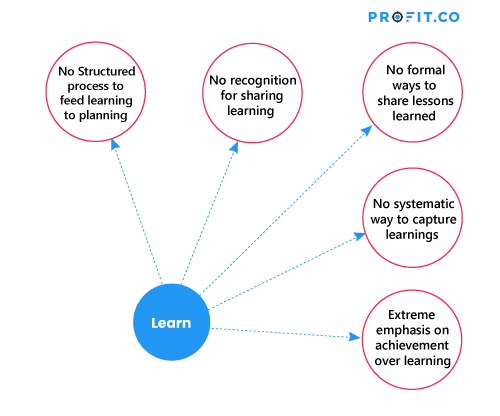
We are not saying that you shouldn’t focus on achievement. Achievement is extremely important. But if you just focus on achievement and completely ignore learning, you may have a problem.
You set out to go from value X to Y of a KPI. But you are stuck at X at the end of the quarter. You haven’t moved the needle or maybe made very little progress. But you would have found out, there are a hundred ways to get to Y, but you tried maybe 70 different ways and pretty much all of them didn’t work. And that’s really good. If you can find a way to institutionalize this, where other people can learn from this, you are making progress. It’s very important to make sure that your organization, as a whole, is able to get the benefit of that learning.
 Results are great. But if you fail to achieve the results you aimed to achieve, you want to understand why. As long as you are sure that the effort and attempt was sincere, you should encourage your team to document the learnings, share them and use that learning to make sure you achieve your key results the next time.
Results are great. But if you fail to achieve the results you aimed to achieve, you want to understand why. As long as you are sure that the effort and attempt was sincere, you should encourage your team to document the learnings, share them and use that learning to make sure you achieve your key results the next time.
No systematic way to capture learnings
As part of your key results progress log, you should be able to document your learning. If you don’t have a systematic way to capture your learnings, how are you going to share them and then learn them?
 A learning log is very important. If you have a centralized learning log that is accessible to everyone you will be able to promote a culture of learning, which is key to the success of your OKR program.
A learning log is very important. If you have a centralized learning log that is accessible to everyone you will be able to promote a culture of learning, which is key to the success of your OKR program.
No formal ways to share lessons learned
Assuming you have a learning log, you should have a way to formally share your learnings. You should have a good way of sharing the lessons learned with appropriate colleagues, and they should be able to collaborate and clarify your learnings. They should be able to learn from the lessons shared.
 You must promote knowledge sharing sessions or brown bag sessions as appropriate to share success, failures and learnings from the failure. It’s very difficult to create a “safe to fail” culture. Recognizing learning by promoting sharing the lessons learned will help establish that culture.
You must promote knowledge sharing sessions or brown bag sessions as appropriate to share success, failures and learnings from the failure. It’s very difficult to create a “safe to fail” culture. Recognizing learning by promoting sharing the lessons learned will help establish that culture.
No recognition for sharing learning
Similar to celebrating successes, you should celebrate learning. If you don’t recognize the effort behind documenting and sharing learning, your employees won’t be motivated to document and share learnings.
You have to make it easy to share learning, especially about failures. Establish a good process to promote learning and sharing. Recognize people for sharing their learning. It takes a lot of courage to admit failure. “Hey, I tried 39 times and I failed all 39 times.” But people should feel comfortable. The organization has to create that culture where that is not just accepted, but also recognized in some way.
Obviously, you can’t build a company with failures. I mean, if you have only failed OKRs in your company you have a problem. This is where you need to plan well, in terms of your mix of OKRs. Some of the stretch OKRs could actually have a lot of uncertainty in them. In those cases learning is going to feed into your next cycle. Whereas certain other ones where it’s a lot more clearer with less uncertainties, then obviously those achievement levels will be higher. Obviously learning will be there everywhere, but achievement levels will be higher with OKRs that are clearer. And that could kind of power your business forward while a subset of your team is working on the less certain OKRs.
 Establish a rewards program that promotes sharing. When you have a continuously learning organization your OKR cycles keep improving.
Establish a rewards program that promotes sharing. When you have a continuously learning organization your OKR cycles keep improving.
No structured process to feed learning to planning
You want your organization to:
- Fault tolerant
- Fail and recover fast
- Not repeat past mistakes
How do you ensure that? Through a structured process that feeds learning to planning. Whatever you learned has to be taken into account in planning the next cycle. The dissemination process can be through weekly reviews, brown bag sessions sharing learnings, audits conducted by consultants, or many other methods that are appropriate.
 Ensure that you allocate time and resources to institutionalize learning and channel that learning towards the next planning cycle. Commit yourselves to learning.
Ensure that you allocate time and resources to institutionalize learning and channel that learning towards the next planning cycle. Commit yourselves to learning.
Conclusion
As mentioned in the introduction, these red flags are just that — flags. You want to take notice of them, acknowledge that they are present and address them if appropriate. When you do that, you’ll have OKR cycles that promote achievement, engagement and learning.
